Armoire: A tall standing wardrobe or closet, often used to store clothes, which can feature one to three doors and sometimes a mirrored panel.
Knowledge Center
The A-Z of furniture: Terminology to know when buying at auction
Abattant: A term used to describe a drop-down flap often seen in the French style of the secretary desk, secrétaire à abattant, concealing drawers and shelves within.
Antique: A piece of furniture or object that is more than 100 years old.
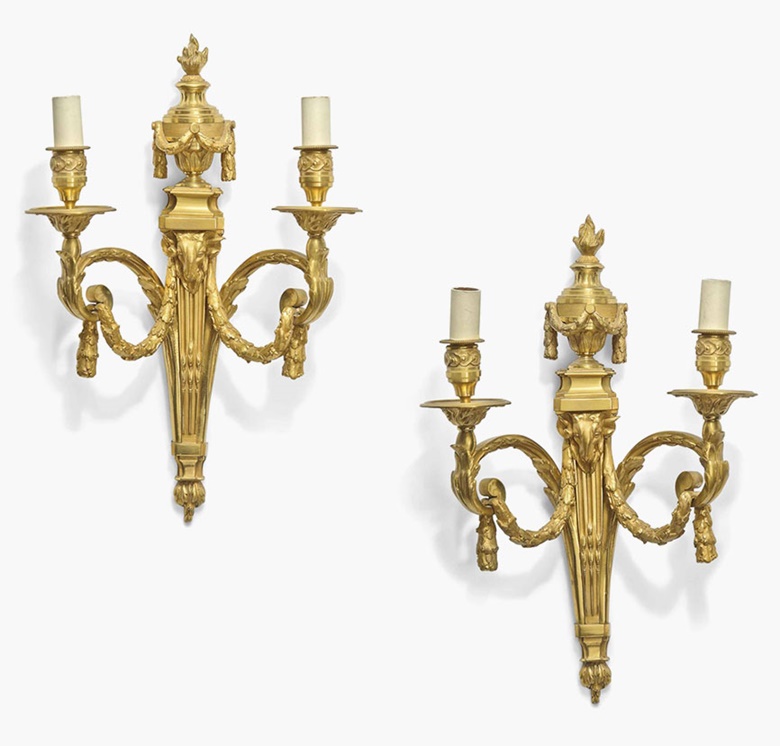
Applique: A term for a category of light which can be affixed to a wall.
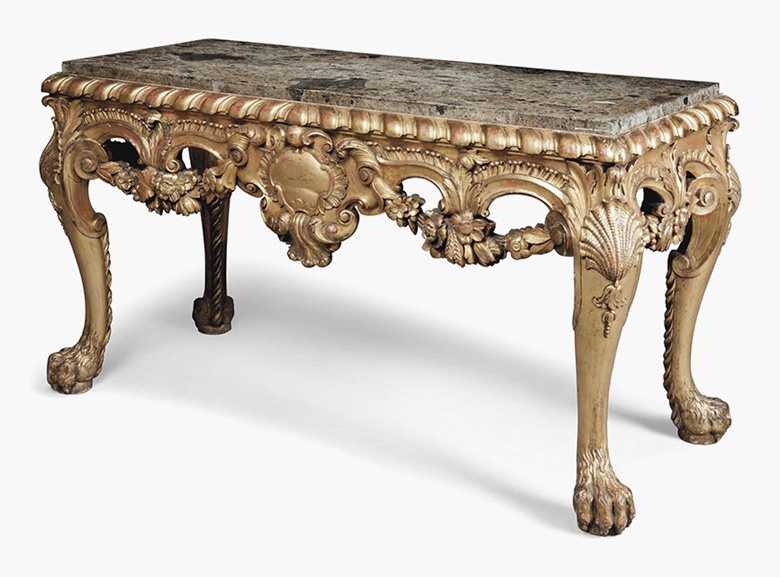
Apron: A decorative element joining the surface of a chair or table with the legs.
Armchair: An armchair can be any chair with arms. However, there are two different kinds: the fauteuil, with open sides, and the bergère, with closed sides. (See Fauteuil and Bergère)
Arrow foot: A type of chair foot that ends in a tapered cylinder, often seen in the 18th century.
Art Deco: A style popular from the 1920s to the 1930s characterised by bold geometric designs.
B
Back splat: The vertical piece of wood running from the frame of a chair to the base of the backrest.
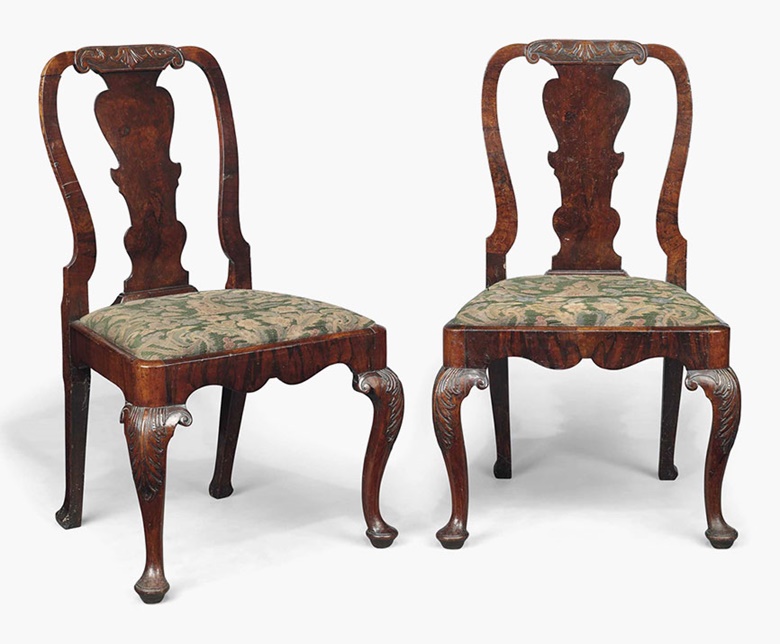
Ball foot: A fully spherical foot on a piece of furniture.
Ball and claw foot: A cast or carved foot consisting of a ball covered by an animal’s claw, in English furniture often that of a lion or a bird. The design is thought to have originated in China, where a dragon’s claw would represent the strong grip of the emperor.
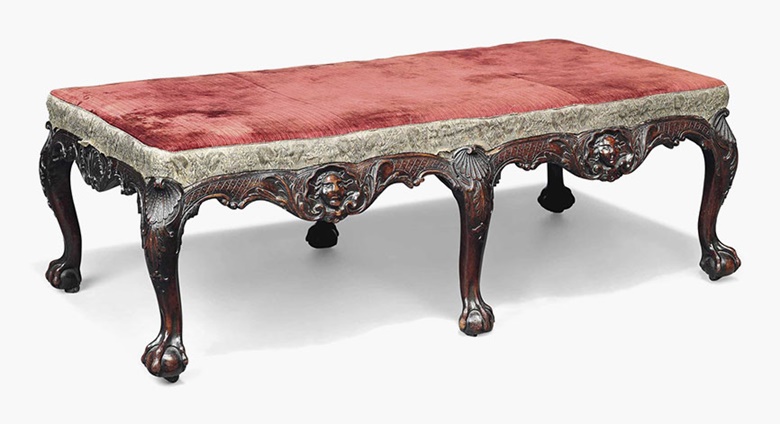
An Irish George II mahogany long stool, circa 1740. Covered in plum-coloured velvet with silvered thread braiding, the frame carved with masks within a trelliswork ground, the cabriole legs headed by carved scallop shells and acanthus leaves, on claw-and-ball feet and recessed castors.
Baroque: A decorative style from the late 16th century through to the 18th century characterised by the use of bold sculptural forms, dynamic surfaces and elaborate ornament.
Barrel chair: Also known as a tub chair, a barrel chair has a round upholstered seat, with the arms forming a continuous line with the backrest.

A Josef Hoffman (1870-1956) nest of four stained beech and brass-topped tables, circa 1906, probably made by J & J Kohn.
Bas relief: A form of carving or moulding where the design projects out from the flat surface of the background.
Bentwood: A kind of wood that has been heated and shaped to become curved.
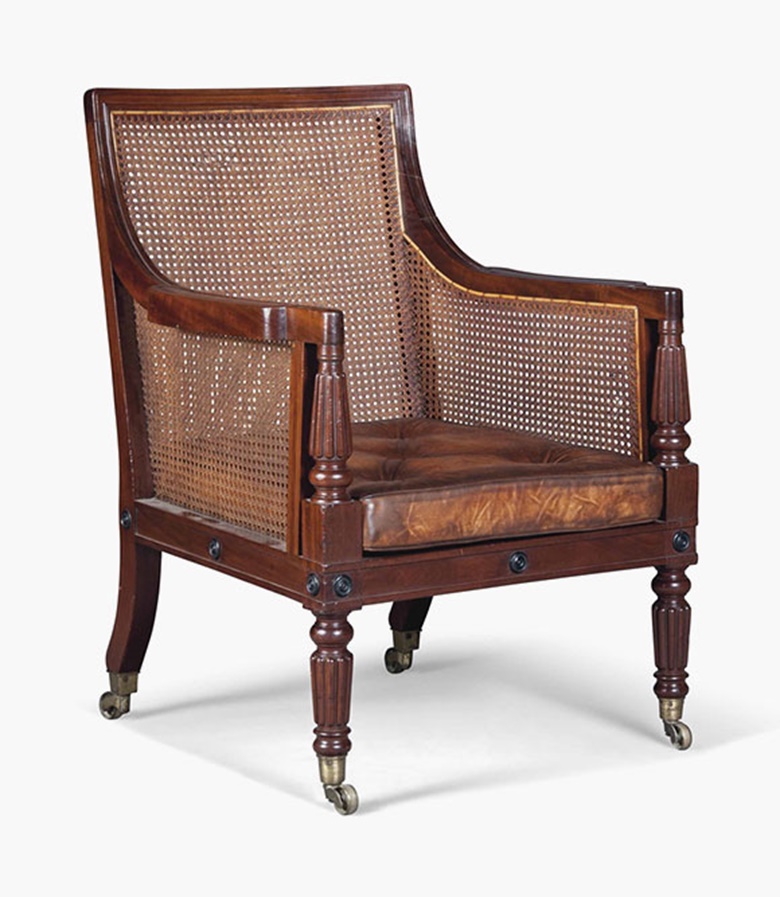
A Regency mahogany caned library bergère. Early 19th century.
Bergère: A kind of upholstered armchair with closed sides that first became popular in the 18th century.
Bevel: An edge that has been cut at a slant, often seen on mirrors.
Biedermeier: Biedermeier encompasses the period between 1815 and 1848 in Central Europe. Influenced by the Napoleonic styles, Biedermeier furniture was produced in Germany and Austria, with simpler designs that often incorporated local timber.
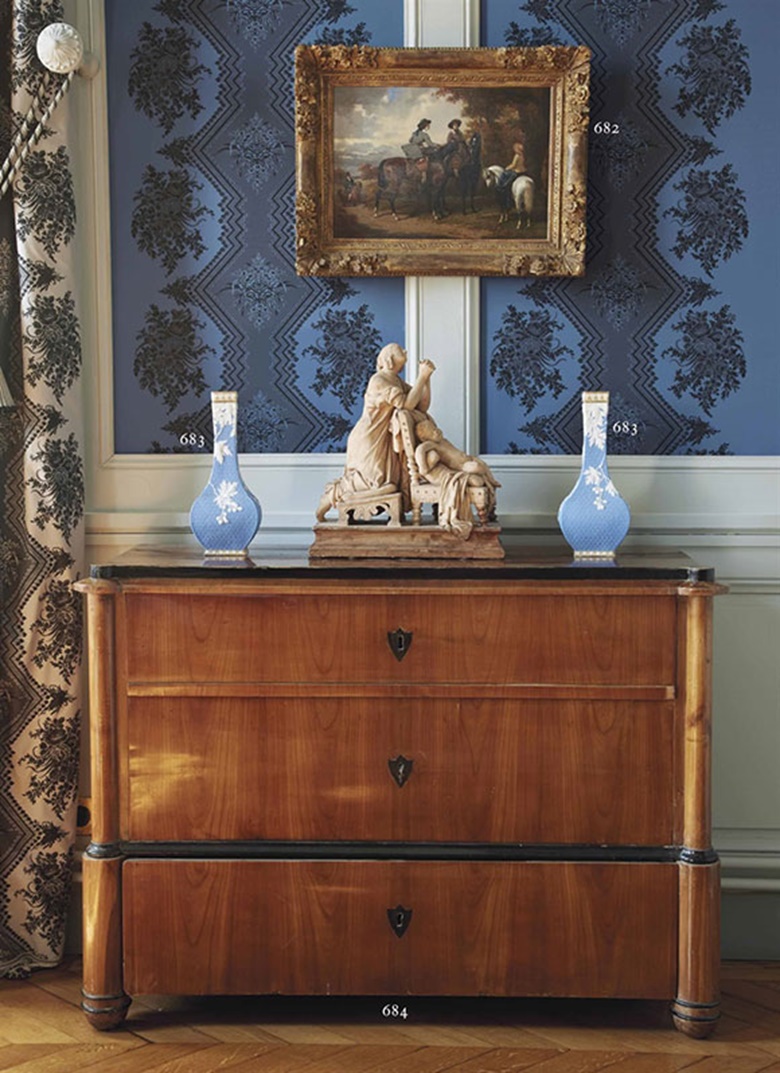
A Biedermeier cherrywood and ebonised commode. Austrian, circa 1825.
Blockfront: A kind of chest divided into three parts whereby the middle part is set back from the sides.
Bombé: A term used to describe the bulging outwards of a piece of furniture.
Bowfront: A chest with a convex front.
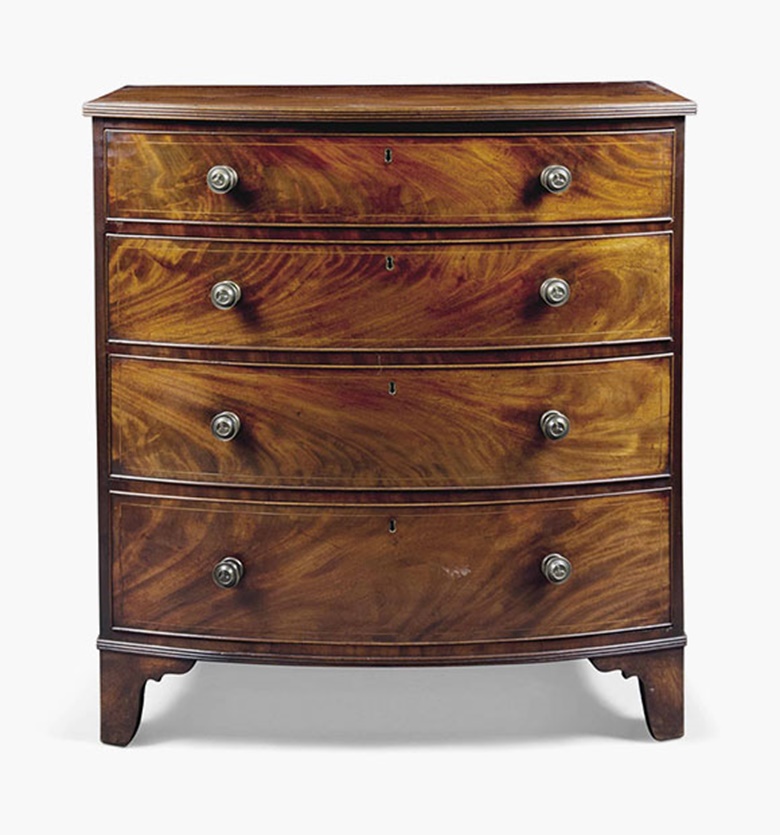
A Regency mahogany bowfront chest. Early 19th century.
Bracket foot: A right-angled foot shaped like a bracket.
Bun foot: A ball foot that has been flattened slightly, like a bun.
Bureau: A chest of drawers often used in a bedroom, sometimes combined with a fold-down desk.
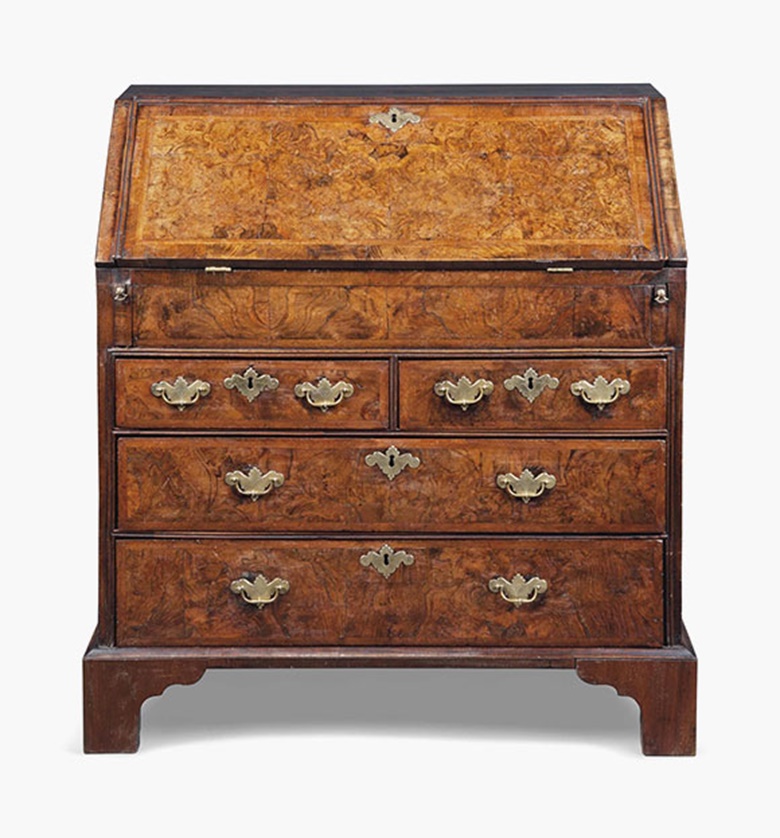
A Queen Anne cross-and-featherbanded burr-walnut bureau.
C
Cabinet: Cabinets can come in many forms, from the industrial to the ornate, and usually consist of drawers and shelves; some feature glass doors for the display of objects.
Cabriole: A kind of leg that curves out from the seat of a chair or base of a table before curving into a foot in a narrow S shape. The name comes from a type of ballet jump in which the dancer leaps into the air with one leg forward.

A lacquer cabinet on an English stand commissioned for the Portuguese market. Momoyama period (late 16th century), English stand, late-18th to early-19th century.
Caning: A technique using the rattan or bamboo plant to create an interwoven seat, back or side of a chair.
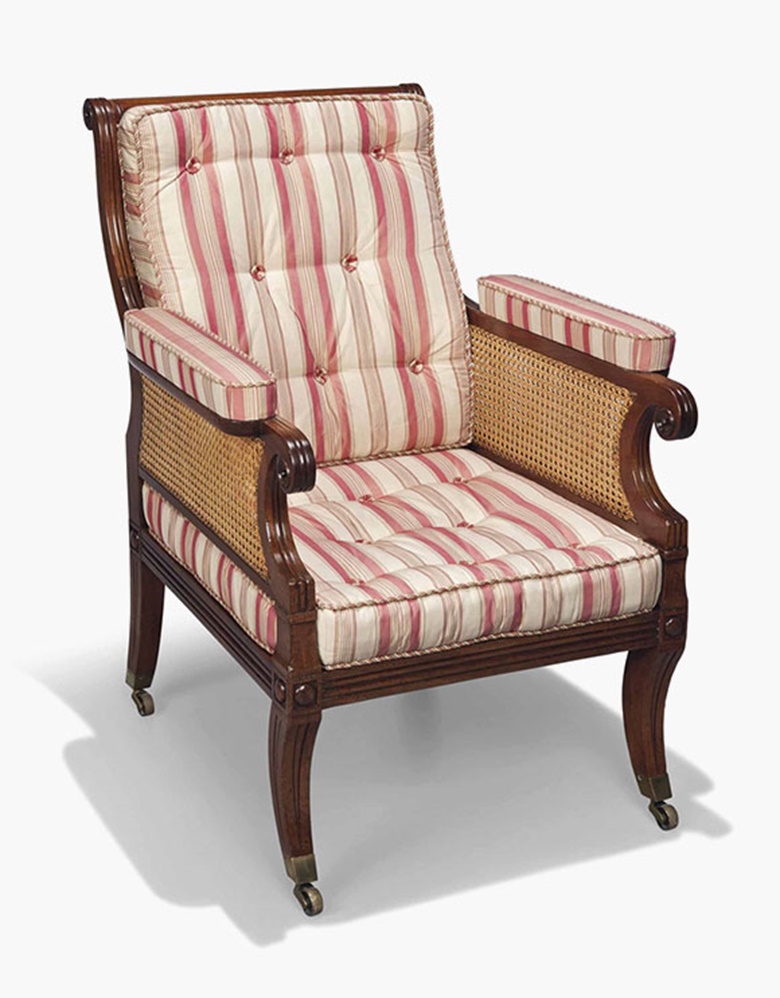
A Regency mahogany caned bergère. First quarter 19th century.
Castor: A small wheel that allows a piece to be moved easily.
Chaise longue: A long low chair for reclining, with a back and single armrest to one side.
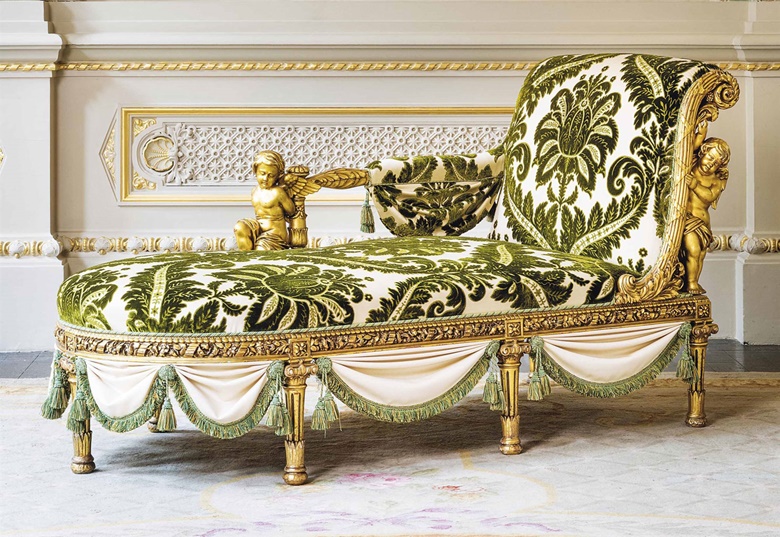
A French giltwood chaise longue by Henri-Auguste Fourdinois, Paris, circa 1878.
Chest on chest: Two chests of drawers stacked together, with the narrower piece on top.
Chest on stand: A chest of drawers on legs.
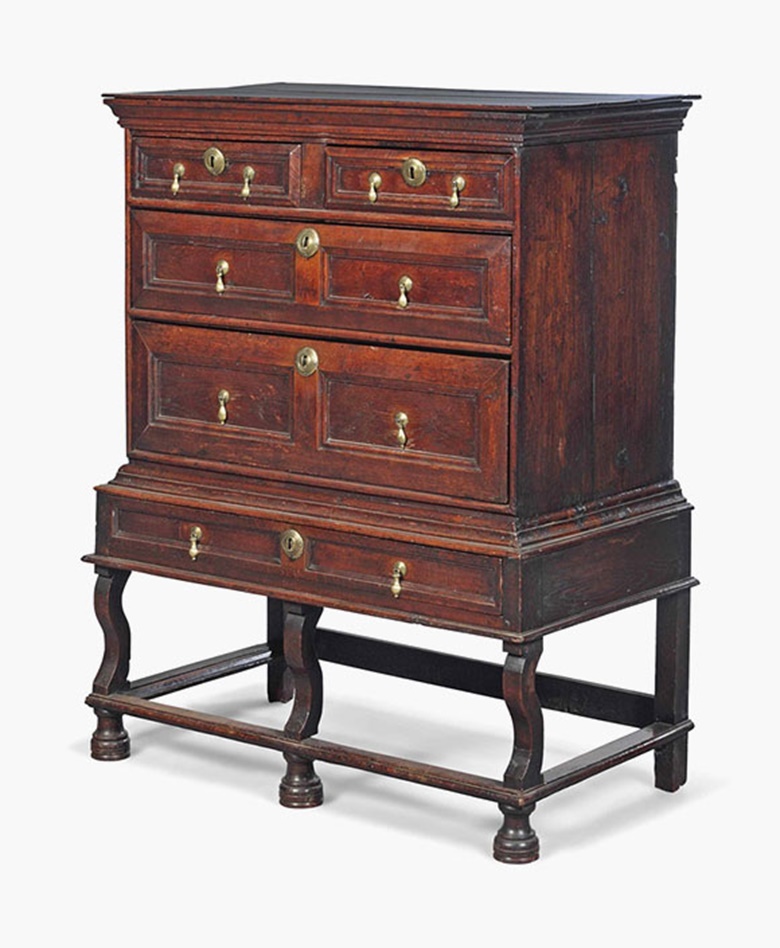
A William and Mary oak chest on stand. The chest late 17th century, the stand 19th century.
Cheval mirror: A freestanding mirror that can be tilted to change the angle of reflection.
Chiffonier: A tall chest of drawers often used to store linen or needlework, sometimes topped by a shelf or mirror.
Chippendale: For Thomas Chippendale, one of the leading cabinetmakers of 18th-century Britain. The term also refers to a style of 18th century American furniture.
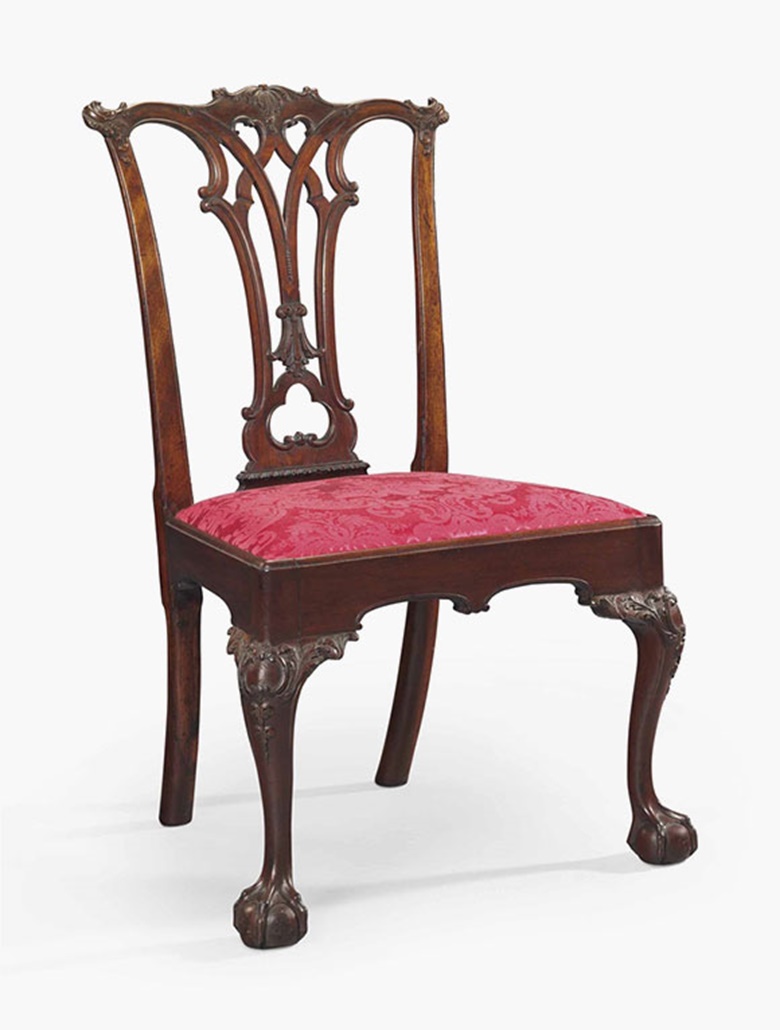
The Deshler Family Chippendale carved mahogany side chair. Probably the shop of Benjamin Randolph (1737-1791/2); the carving attributed to John Pollard (1740-1787), Philadelphia, circa 1769-1770.
Claw foot: A foot carved to resemble an animal’s claw (see also Ball and claw foot).
Club chair: A chair with a low back, often upholstered in leather.
Coffee table: A long low table to be placed in front of a set of chairs or a sofa.
Commode: Not to be confused with a chair containing a chamber pot, the traditional commode is a cabinet with doors or drawers, often highly ornamental.
Console table: A narrow table that is designed to be placed against a wall.
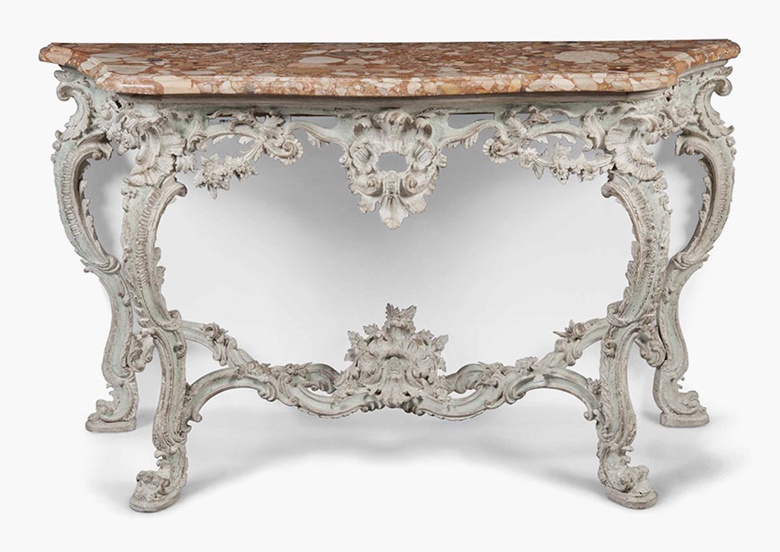
An Italian or German white and pale-green painted console table. Mid-18th century.
Credenza: A low sideboard with doors, used for storage or for serving food. The name comes from the Italian word for ‘belief’; in the 16th century the act of credenza entailed the tasting of one’s food by a servant to ensure it was not poisoned.
Cresting: The carved decoration on the top rail of a piece of seat furniture or mirror.
D
Damask: A lustrous fabric with a reversible pattern and figured weave, often of linen, cotton or silk, which can be used for upholstery.
Davenport: A narrow writing desk with a sloped top above drawers.
Daybed: A long sofa, similar to a chaise longue, that can double up as a bed, often with a small headboard at either end.
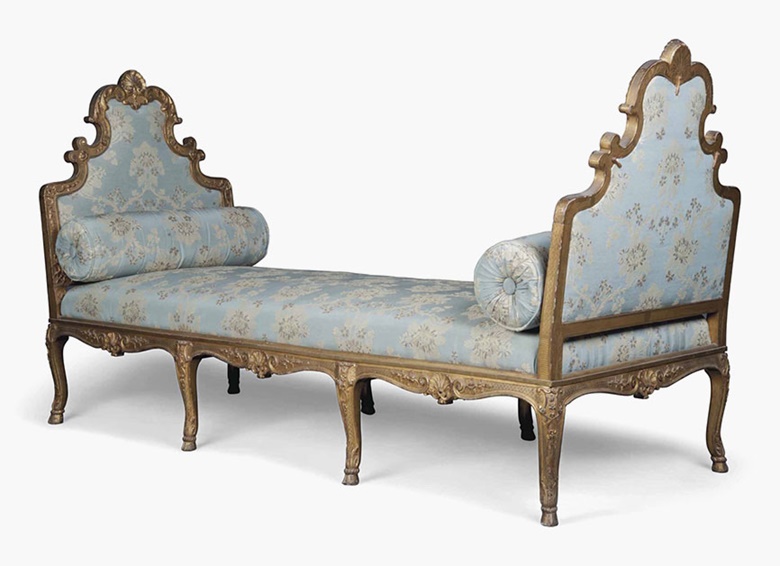
A French giltwood daybed, 19th century, of Regence style. The shield-shaped ends covered à chassis and carved with shells, acanthus and flowerheads, on cabriole legs and hoof feet, regilt.
Dentil moulding: A form of decoration of evenly spaced blocks often used on a cornice. From the Latin for tooth, dens.
Dresser: A type of sideboard, often with shelves above drawers for the display of plates.
Drop-leaf: A kind of table with extendable parts that hang by its sides when not in use.
E
Ebonising: The process by which wood is stained dark to resemble ebony.

A pair of ebonised and gilt-heightened open bookcases. Late 19th century.
Empire: A style dating to Napoleon’s reign (1804-1814) characterised by Egyptian, Greek and Roman motifs.
Escutcheon: The term for the plate of metal that surrounds a keyhole, often decorative. From scutum, the Latin for shield.
Etagère: A piece of furniture with open shelves used for the display of ornaments.
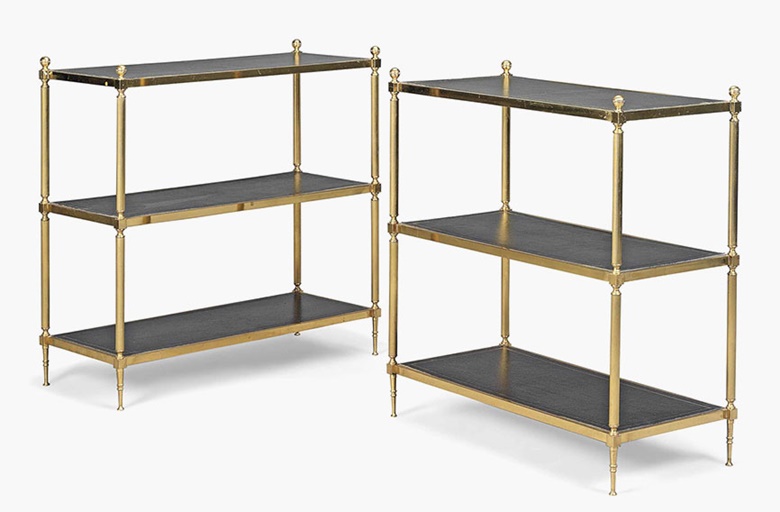
A pair of gilt-metal three-tier etagères.
F
Fauteuil: An armchair with open sides, usually upholstered on the seat and the back, leaving the wooden frame exposed.
Fluting: Vertical grooves which form an elliptical-shaped recess, often employed on columns.
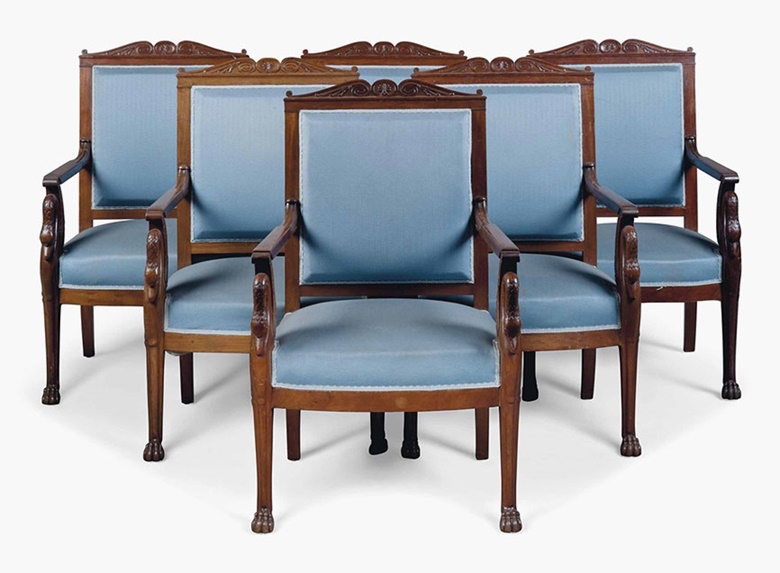
A set of six Louis Philippe mahogany fauteuils. Second quarter 19th century.
Frieze: A broad, horizontal band which is often decorated with painting or sculpture.
Front rail: The piece of wood that runs between the front two legs of a chair.
Four-poster bed: A bed with high posts at each corner and sometimes a canopy.
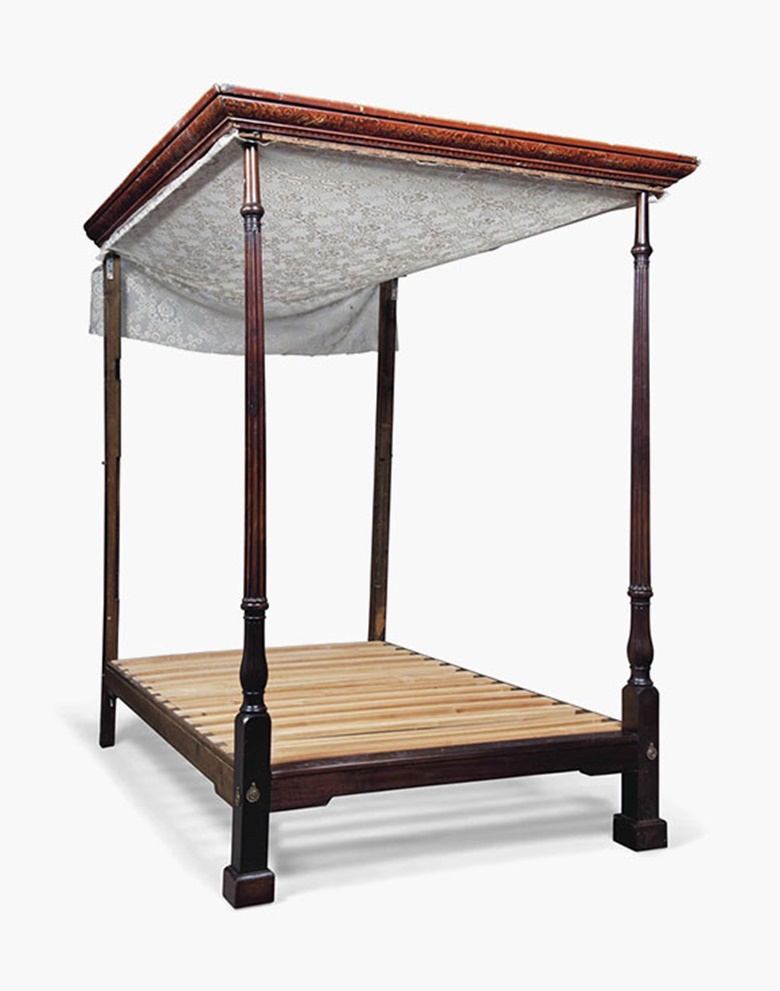
A George III mahogany and polychrome-painted four-poster bed. Late 18th/early 19th century and later.
G
Gallery: An ornamental wood or metal rail around a piece of furniture.
Georgian: Term referring to the artistic output in the decorative arts during the reigns of the first four members of the British house of Hanover, between the accession of George I in 1714 and the death of George IV in 1830.
Gesso: From the Italian for chalk, a material that can be moulded into elaborate designs for cornices, frames, etc.
Gilding: A technique of applying gold leaf to wood for decoration.
Gillows: A firm founded by Robert Gillows in 1703 in Lancaster, known for its elegant designs and superior craftsmanship. Its pieces are still highly sought-after by collectors today.

A Victorian oak tripod table. Mid-19th century, after a design by Gillows.
H
Hassock: An upholstered footstool or short bench.
Herringbone: A way of using veneer as decoration, also known as feather banding, whereby two strips of veneer are laid at a 90-degree angle around the edge of a piece of furniture to create a herringbone-patterned border.
I
Inlay: A technique of using a contrasting material to create a decorative pattern on the surface of a piece of furniture.
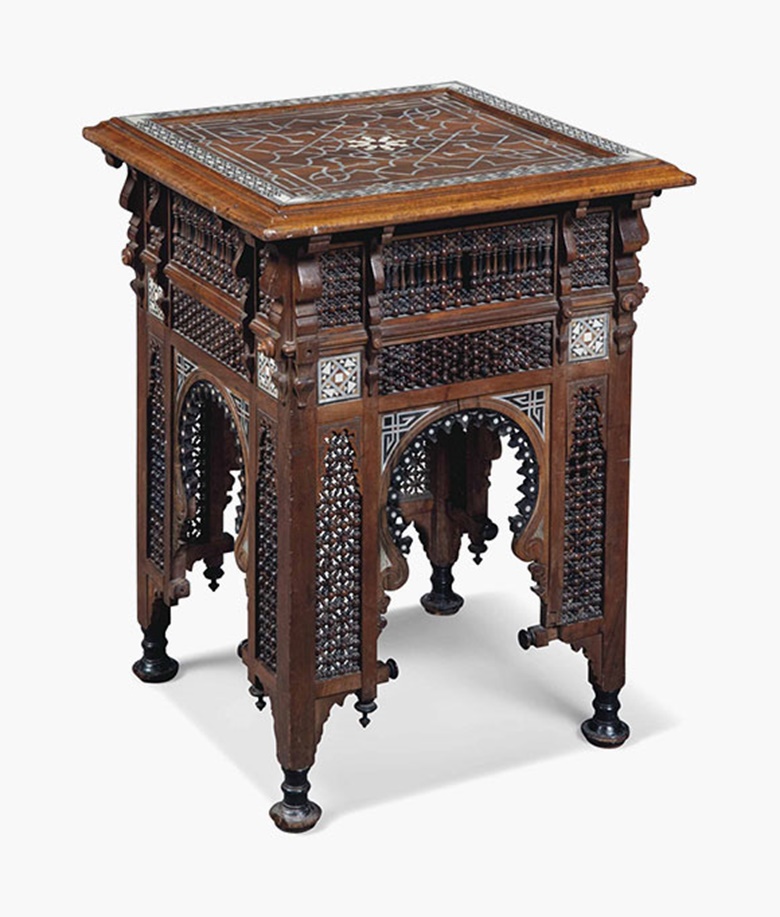
A ‘Moorish’ ivory and mother-of-pearl-inlaid hardwood and ebonised occasional table, circa 1900.
J
Japanning: A technique developed in Europe which imitates the lacquering applied to Asian furniture.
Jardinière: A pot for holding plants, often large and ceramic for outdoor use, but can also be a more elongated shape for indoor use.
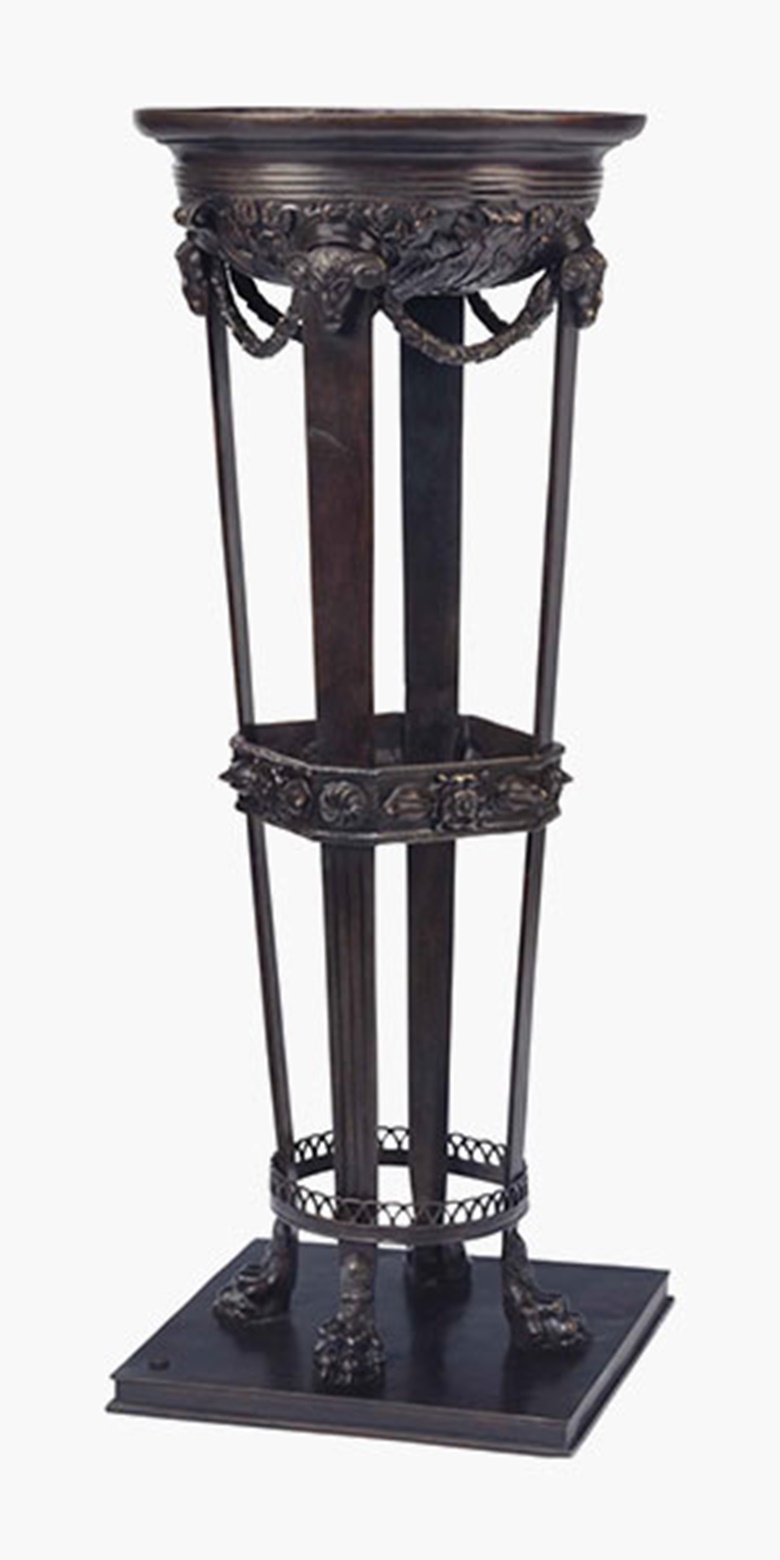
An Italian patinated bronze jardinière. late 19th/early 20th century, cast by Fonderia Chiurazzi, Naples. After the model no. 447 from the Chiurazzi Workshop Catalogue, with Chiurazzi foundry seal and incised '4/299'.
K
Kneehole desk: A type of desk with a recess in the front to make space for one’s knees.
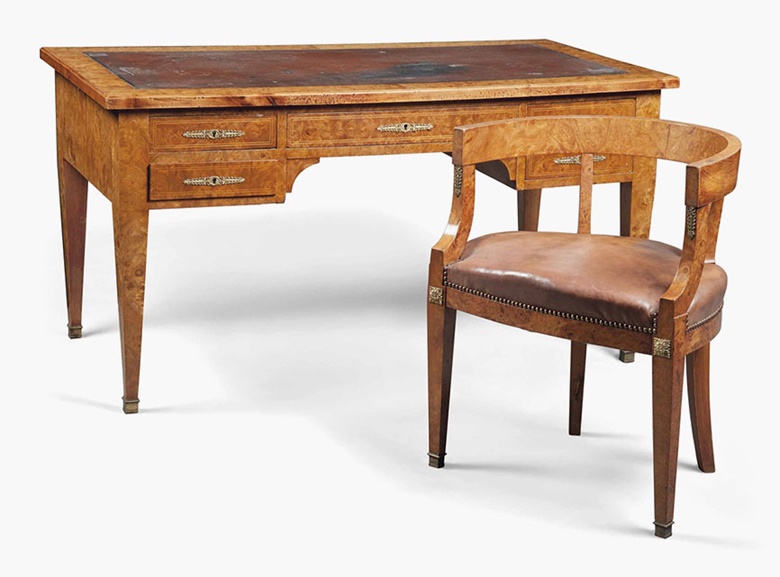
A French burr-elm desk and matching chair. Empire style, late 19th/early 20th century.
L
Lacquer: A high-gloss varnish used in Chinese and Japanese furniture.
Loveseat: A small sofa designed for two people, often made in an S shape so that a conversation can be held face-to-face.
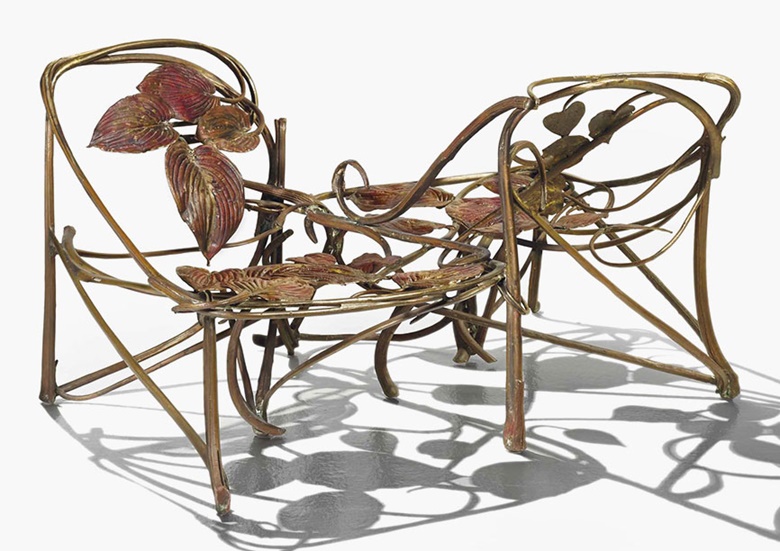
Claude Lalanne b. 1925, Love-seat, 1972. Gilt bronze, galvanized copper.
Lowboy: A low side table usually with three drawers and cabriole legs.
M
Marquetry: A style of inlay which uses different types of veneered wood or other materials placed together to form a pictorial pattern. Marquetry can be contrasted with parquetry, which forms a geometric pattern.
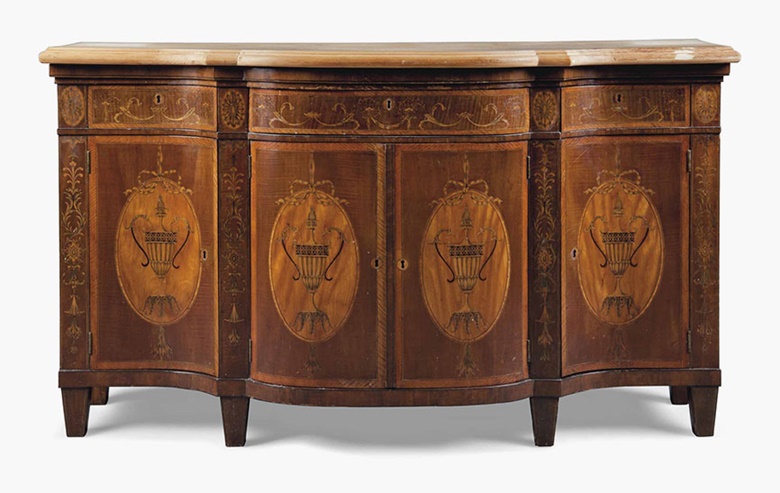
A late Victorian mahogany and marquetry serpentine side cabinet. Of George III style, late 19th century.
N
Neoclassic: A style of design that revives classical motifs, popularised from the second half of the 18th century.
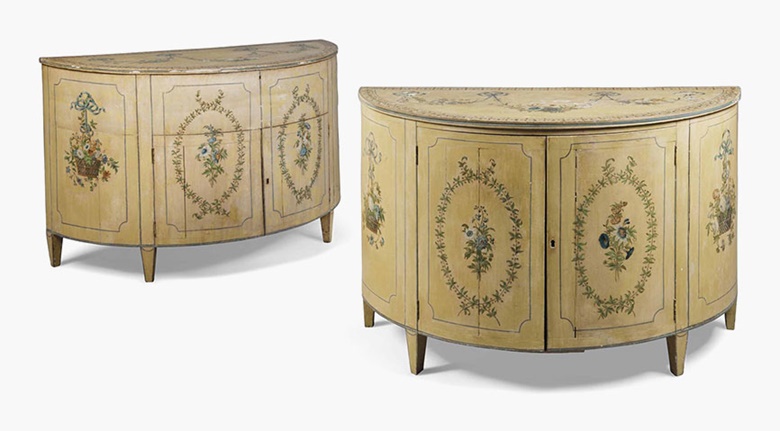
A close pair of George III polychrome-decorated demi-lune commodes. Early 19th century.
Nesting tables: A set of small tables that fit inside each other.
O
Occasional table: A catch-all term used to describe small freestanding tables such as coffee or side tables.
Ormolu: A generic term for gilt metal.
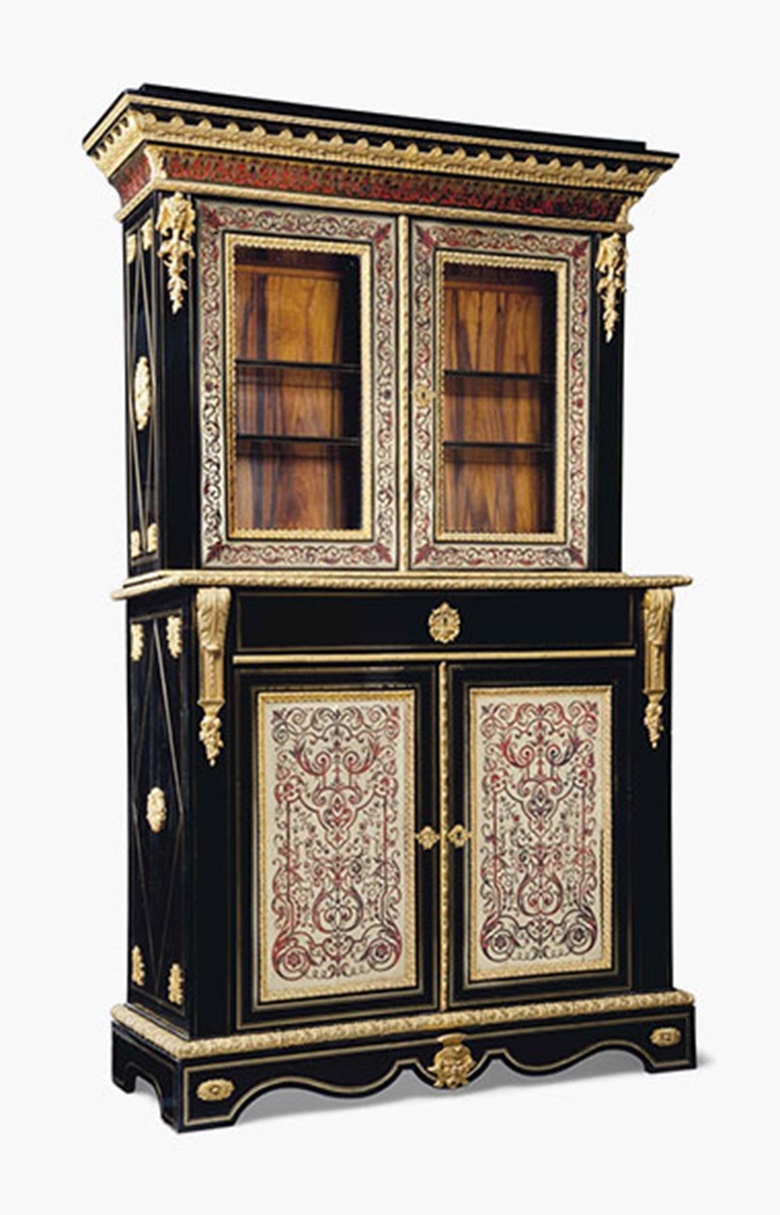
A Napoleon III ormolu-mounted, cut-brass and red tortoiseshell-inlaid, ebony ‘boulle’ marquetry side cabinet.
Ottoman: An ottoman is usually a low upholstered stool that can be used as a foot rest and sometimes also for storage, adopted from similar styles in the Ottoman Empire.
P
Pad foot: A kind of foot often found on cabriole legs that ends in a flat oval disk.
Palmette: Decorative motif derived from classical architecture loosely resembling an open palm leaf, often used interchangeably with the term anthemion.
Parquetry: Similar to marquetry, parquetry is a technique used on floors and furniture of contrasting wood to create a geometric pattern.
Pedestal table: A table supported by a single leg.
Pembroke table: A drop-leaf table often with a drawer and twin flaps to the long sides.
Pie-crust edge: A scalloped motif either carved or moulded on the edge of a table.
Pietra dura: A form of mosaic decoration using semi-precious stones, mostly seen on tabletops.
Plinth: The term for the squared base of a piece of furniture if it does not have legs.
Q
Queen Anne: A style of English furniture made between 1702 and 1714, simple and elegant in style and favouring walnut.

A Queen Anne cross-and-featherbanded burr-walnut bureau. Early 18th century.
Reeding: The convex equivalent of fluting, reeding comprises parallel lines of rounded moulding.
Regency: The term refers to English furniture made between 1800-1830 in a style promoted by George, Prince of Wales, who reigned as George IV.
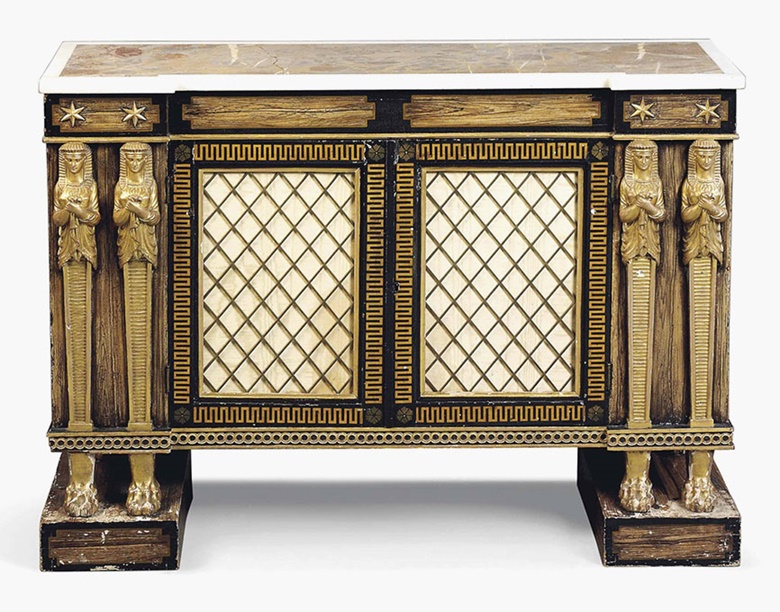
A Regency Egyptian revival simulated rosewood and giltwood side cabinet. Early 19th century.
Rococo: An elaborate style of furniture that followed the Baroque in the 18th century, characterised by scroll and foliate motifs.
S
Secretaire: A French term for a standing chest of drawers with a drop-down writing desk (see Abattant).
Shoe: The horizontal section of the back seat rail of a chair that supports the bottom of the splat.
Sideboard: A long cabinet often used in dining rooms for serving food and as storage.
Side chair: A traditional dining chair with no arms that would fit in at the side of a dining table.
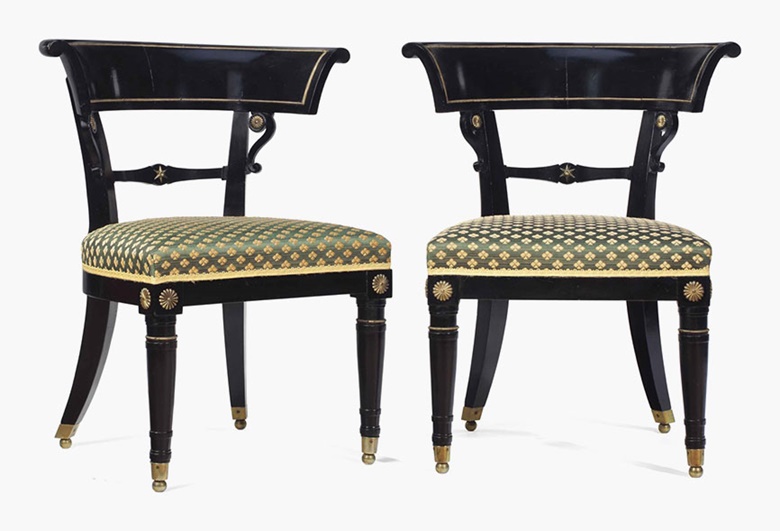
A pair of Regency gilt-metal mounted, ebonised and fruitwood side chairs, circa 1820.
Slat back: A chair back consisting of vertical slats instead of a single panel.
Sofa: An upholstered long seat with back and arms.
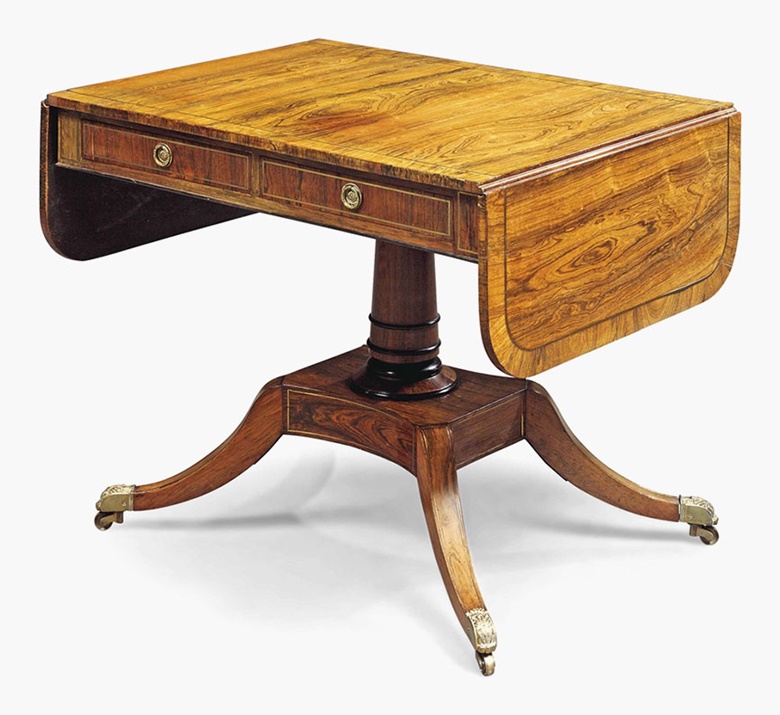
A Regency rosewood sofa table. Early 19th century.
Sofa table: A high, small table to be placed alongside a sofa with twin flaps to the short ends.
Spindle back: A chair with turned spindles instead of a single panel as a back rest.
Straw marquetry: A form of marquetry which uses straw instead of wood to create a contrasting pattern on the surface of a piece.
Stretcher: Often forming an H, X or Y shape, the stretcher runs between the legs of a chair or table to reinforce the structure.
T
Tallboy: A tallboy, or chest on chest, is a high chest of drawers.
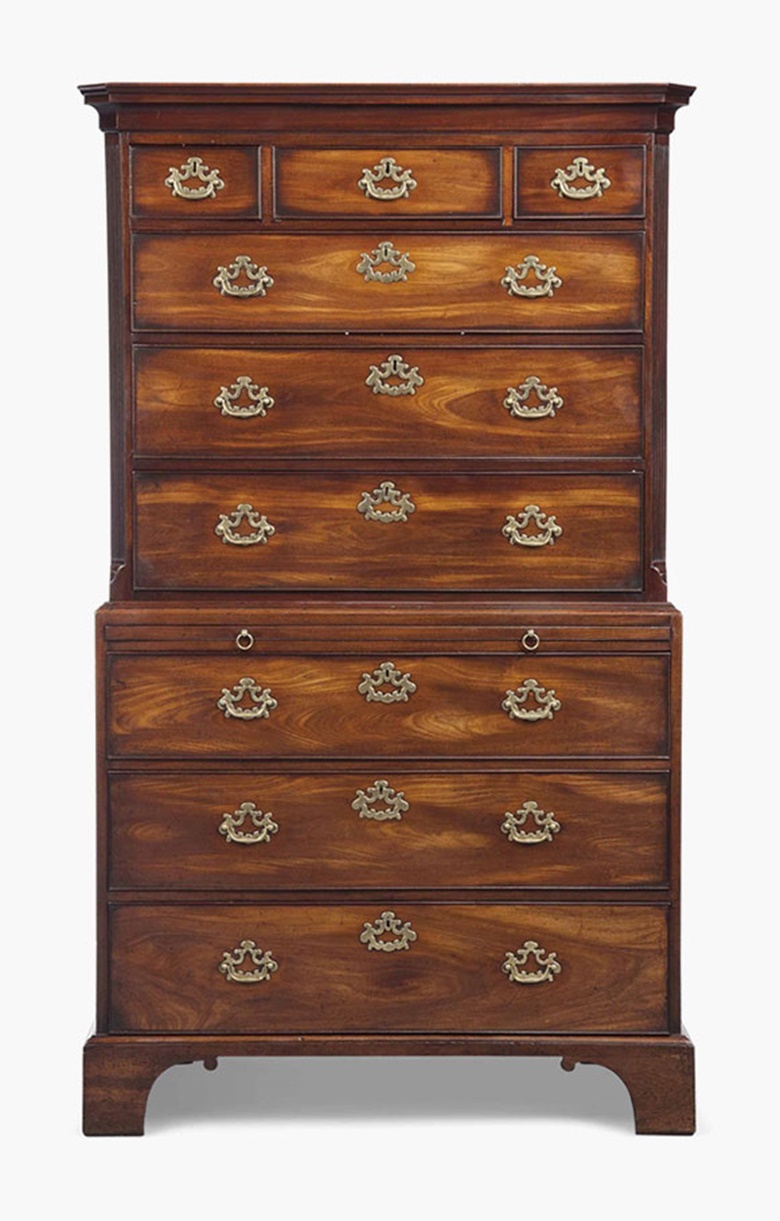
A George III figured mahogany tallboy. Late 18th century.
Term: A pillar surmounted by a carved male or female bust, usually armless, which tapers towards the base. Also known as a herm, after the posts bearing the carved head of Hermes which were used as boundary markers in ancient Greece.
Trestle table: A table supported by an upright at each end.
Tub chair: See Barrel chair.
U
Upholstery: The padded covering on furniture, usually made of horsehair, foam or springs and covered in decorative fabric or leather.

A late Victorian brown leather Chesterfield sofa. Late 19th century.
V
Veneering: The technique of applying thin layers of wood to a piece of furniture.
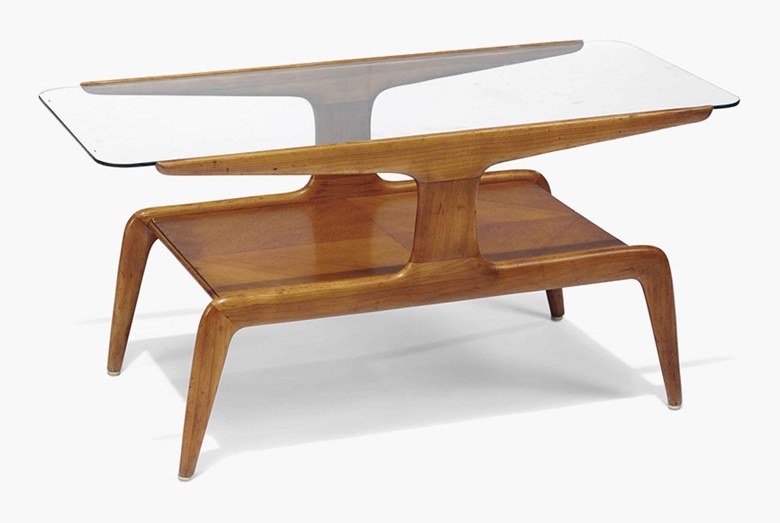
A stained and veneered beech two-tier occasional table in the style of Gio Ponti. Third quarter 20th century.
Victorian: Refers to the period coinciding with the reign of Queen Victoria of Britain from 1837 to 1901.
Volute: A spiral scroll characteristic of Ionic capitals, often used as a decorative form on arm rests and feet in furniture.
W
Webbing: A technique of interweaving elastic or fabric to provide support to an upholstered arm, back or seat.
Wicker: A term given to pieces woven from rattan, willow or reed.
Windsor chair: A classic design with a curved top and spindle back.
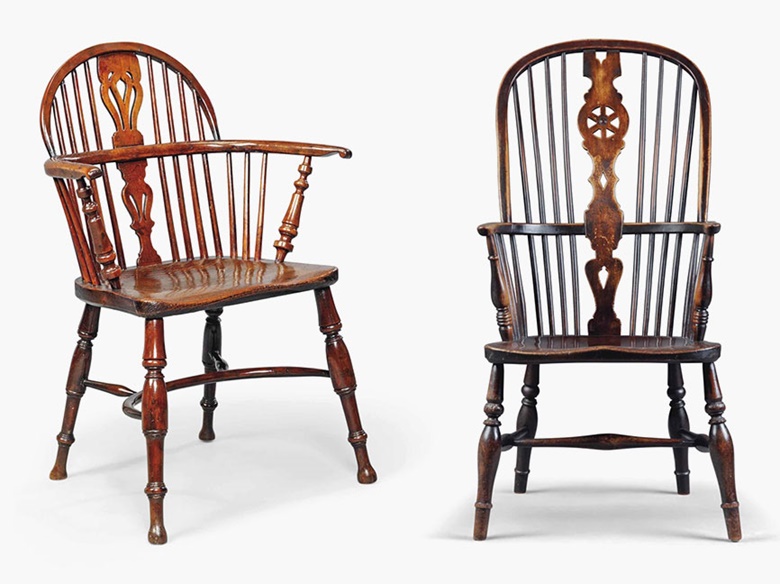
A George IV yew and elm Windsor armchair, early 19th century. Together with a Victorian beech and elm Windsor armchair.
Wing back: A chair with wing-like side panels protruding from the top of the backrest and above the arms in order to shield one from draughts or the heat of a fire. Also known as a bergère à oreilles, or a chair ‘with ears’.
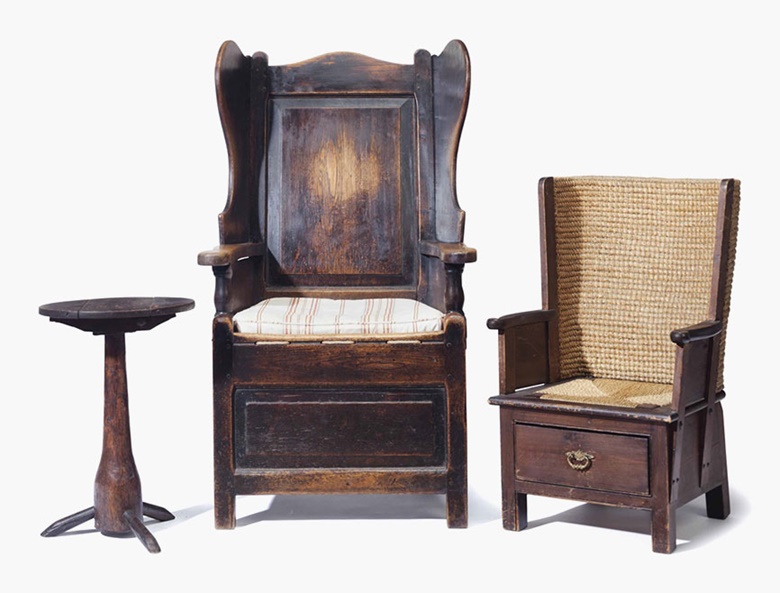
An English oak wingback chair, 19th century. Together with a Scottish Orkney Island child's chair and an oak and fruitwood side table.
X
Y
Z
Zitan: a tropical hardwood ranging in colour from dark purple brown to reddish brown and considered, together with huanghuali, the most precious and luxurious material used in Chinese furniture.